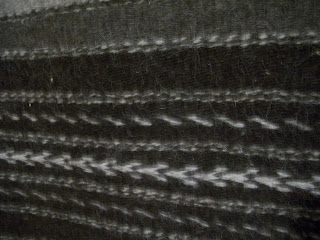 |
| Colcha Embroidery is an unique style of embroidery evolved in colonial New Mexico. Colcha is done in handspun, hand-dyed wool on a plain-woven wool ground cloth called sabanilla. Sometimes the entire ground is covered with embroidery. The subject matter included ornate and fanciful flowers or birds. Colcha is used for decorative wall pieces and altar cloths as well as household items. |
 |
| Rio Grande "Vallero" Frezada by Leyba Family, Trampas NM 1885-95 |
 |
| Handspun natural and aniline dyed wool weft and commercial cotton warp |
 |
| Rio Grande Blanket--no date or other information given |
 |
| Banded Rio Grande Blanket, ca. 1855 |
 |
| Brazilwood and natural dyes--wool warp and weft. This and so many others were gifts from Paul Peralta Ramos, son of Millicent Rogers |
 |
| A weaver would stand up to weave on such a loom. The warp threads for a blanket are raised or lowered on only two harnesses and there are only two foot treadles. |
 |
| Loved looms never die! They just keep on weaving and weaving! |
 |
| Rio Grande Classic Serape, ca. 1800's |
 |
| And from contemporary hands comes this Two Gray Hills Rug, woven by Lucy Whitehorse of Dine, AZ--all natural colored wool for weft; hence, the region of Two Gray Hills. |
 |
| Crystal Rug with Squash Blossom Motif by the hands of Maggie Johnson, Dine, AZ, ca. 1975 |
 |
| Rio Grande Hispanic Banded Rug by Zoraida Ortega of Velarde, NM, ca. 1980 |
 |
| This is the last room of the exhibit hall--a wall of handwoven blankets--all fine in workmanship. |
 |
| And we come to the last blanket in the room....................... |











No comments:
Post a Comment